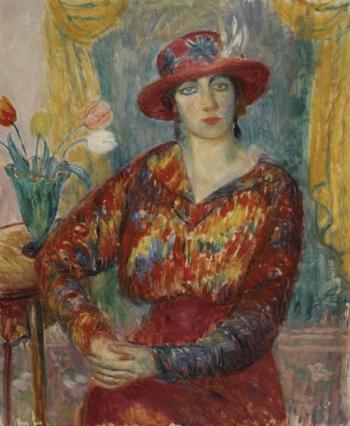Serendip is an independent site partnering with faculty at multiple colleges and universities around the world. Happy exploring!
Red Blouses and Tulips

Phoenix
Mlord
Play in the City 028
Red Blouses and Tulips
I am sitting on the floor in front of her. She looks mildly accusing; although she is being ladylike, she fixes you with her stare and her mouth is set. Her head is ever so slightly cocked.
She’s a William James Glackens painting, a white woman, middle to upper class, wearing a dress with a red skirt over ordinary sized hips and a multicolored, but predominantly red, bodice over comparatively massive bosoms. She wears dangly earrings, a red flowered hat, and makeup.
She sits—on what, the viewer can’t see. The floor or lower wall behind her is pink and flowered, and the upper wall is light pink or white. Yellow curtains above her head frame shapeless greenness. It could be a window showing a hill, or a green tinted window, or merely an expanse of green paint on the wall. A table with physically insufficient legs for standing holds a vase of four roses, in red, yellow, pink, and white. She rests her elbow on it, although by the laws of perspective it ought to be too tall for that. Her left sleeve is significantly darker than anything else in the painting. I am not sure why. The light appears to be essentially equal throughout the painting elsewhere.
I am standing across the room from her. She is hanging at my eye level, meeting my eyes. Since she is sitting and I am standing, I wonder if her painter was particularly short to capture her expression so head-on. I decide the floral pink is part of the wall. If I were looking for a representation of real life, I would say the perspective leaves something to be desired, but as always I must assume that’s not the point.
I am sitting on a bench against the next wall over. At this angle, I think the painter was sitting across from her. She seems friendlier. Perhaps we are sitting to conduct a business meeting, not casual, but still friendly. At this distance, her bodice is less chaotic and more obviously merely striped.
Her eyes grow softer. She understands. She is in the same situation. Both of us are unsure about this meeting.
She is flanked by two landscapes, with a painting of a group of people above her head. That grouping is flanked by two still lifes of flowers. Above it, another landscape. All three landscapes are of the ocean. Red in the flowers of the still lifes, a cloak worn by someone in the group, and something undefined in both landscapes all pop because of her red, but the oceans bring out the green in her background, and emphasize a green shadow on her face.
I come closer again. Now, she seems contemplative.
Tempera paint, I think—the brush strokes confirm paint, and the texture is all wrong to be oil.
I go home, and I still don’t know her name. I look her up. There is a copy of her picture on the internet, but she is far darker, as though the photo was taken at night. Her color is lost, but her expression remains. The accusing expression returns, and on its heels the kind one. She is not a woman to be underestimated or crossed. She is a woman who is sitting here and posing because it pleases her, not you, who understands your thought process without your explanations, and yet does not easily forgive. She is a woman to be reckoned with.
I read the text almost as an afterthought, though it is what I came for. Her name is Woman in Red Blouse with Tulips (oh, so they’re tulips, not roses, well, they look very much alike in paint), and she is oil after all (how did he pull that off? The canvas is still visible through some of the paint strokes). Some numbers pertaining to size and time also appear, but mean next to nothing. All of these details have come to mean very little, next to the personality conveyed by the paint.

Woman in a Red Blouse with Tulips. The Barnes Foundation. The Barnes Foundation. 2013. Web. Nov. 24 2013.


